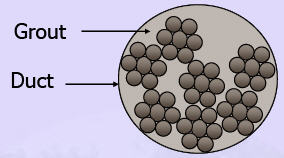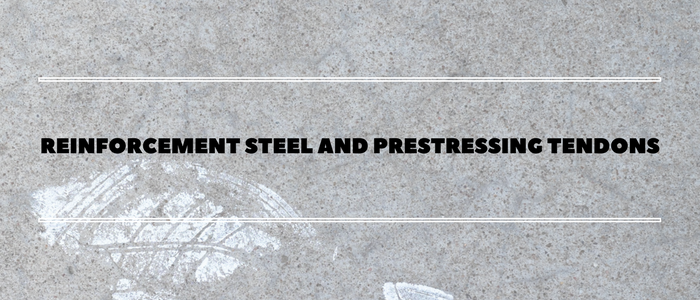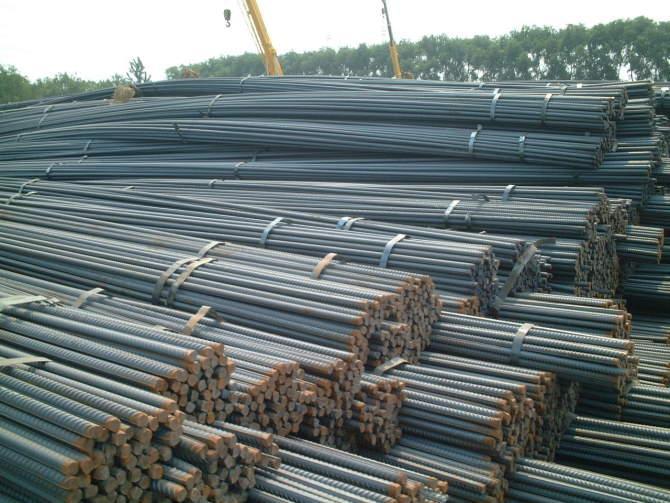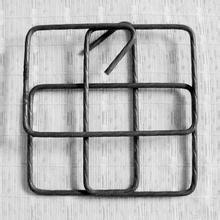Reinforcing Steel
Because in prestressed concrete structures the role of primary reinforcement has largely been replaced by prestressing steel, an unfortunate tendency has been to denigrate the importance of supplementary conventional reinforcing. Conventional reinforcement fulfills the essential functions of distribution and resistance in the orthogonal directions to the prestressing, most typically in the transverse direction. It serves to augment prestressing steel in critical areas of concentrated stress. It serves as confinement, resisting the bursting and delamination stresses due to prestressing itself. It also resists punching shear under concentrated loads.
The role of reinforcing steel is secondary to the structural behavior and is concerned with stress distribution and crack prevention, so close spacing with small bars is preferable to large, widely spaced bars. Confining reinforcement usually consists of spirals, although hoops (welded rings) perform best under ultimate loads. Mechanically headed bars have been used on a number of recent major structures. Subject to the design engineer’s approval, bundling of bars may be acceptable, especially in cast-in-drilled shafts and columns. This clustering of bars together often facilitates concrete placement. For splices, mechanical splices are best, although lap splices may be used.
Reinforcing bars typically develop anchorage by having an embedment length that extends beyond the location of high stress, preferably terminating in a confined zone or core. Bends, such as those of stirrups, are only about 70% effective in ultimate capacity, as the concrete under the bend crushes at high stress. Headed bars typically anchor the bar, develop its full strength, and permit the use of larger bars or those with higher yield strength. They are much easier to install than stirrups and reduce congestion of steel bars. It is a serious mistake by both designer and constructor to reduce anchorage lengths to the absolute minimum permitted by code or specifications, as practicable placement tolerances frequently result in inadequate length for anchorage. A typical concern arises with the provision of cover—that is, the thickness of concrete outside the reinforcing bars. Because cover is a major factor in durability, as well as in mechanical behavior, it is normally specified to a tolerance of –6 mm (–1/4 in.).
Main bars should be tied with wire at every intersection. Stirrups or hoops must be tied to the longitudinal bars at three intersections so as to prevent displacement along the bars during concreting (a typical problem in concreting that has serious consequences). Lap splices in reinforcement are another source of difficulty. These can be more easily achieved if the bar is a little longer than the minimum required by code. The designer or the code should specify whether or not the overlapping bars must be tied together with soft iron wire. In general, this is good practice. Compression splices are rendered most efficient by being well tied together at both ends; otherwise, the concrete may locally crush under one or both bar ends. Lap splices, especially those in tension, must be confined on both orthogonal axes, transverse and through thickness.
Reinforcing bars require support. Both concrete dobie blocks and plastic chairs are used and are left in place in the completed concrete structure. Reinforcing bars are frequently epoxy coated to protect against corrosion. The electrostatic fusion process is most widely used. Problems sometimes occur with insufficient thickness of epoxy over the lugs of the deformations. Regardless of the method of manufacture or whether the bars are bent before coating or bent afterward, there will be some scratches and some “holidays” due to handling and placement. Fiber slings and pads must be used. Abraded areas must be touched up in the field after placing. Special care must be taken to ensure that the reinforcing steel is stored in a salt-free area before concreting—that is, where seawater chlorides cannot be carried by fog or spray to contaminate bars. In critical areas and special applications, corrosion-resistant or stainless steel reinforcement is utilized, enabling a reduction in cover and providing long-term durability.
Prestressing Tendons and Assemblies
Prestressing tendons are made of cold-drawn wire, both parallel and stranded, or rods of high-yield strength steel. Bars and rods consist of heat-treated alloys, which have been prestretched beyond yield and tempered in the manufacturing process. They are rolled with spiral threads, either cut in upset ends or continuously rolled so the threads also act as deformations. Cold-drawn wire is typically low alloy that has been tempered. Wires are generally wound into seven-wire strands and prestretched. For pretensioning, the strands are directly embedded in the concrete, gaining anchorage by bond on the twisted surface. For special applications, such as railroad ties (sleepers), a wire with a deformation is stranded into one outer layer of the strand to shorten the stress transfer length. For post-tensioning, anchorages are locked to a socket by serrated wedges, locking into a female sleeve. High-strength bars are used primarily for short tendons. Wedges can be used to anchor bars although threaded connections are more often employed. These permit restressing to counter the set typical of wedge anchors.
Bars, wires, and strands are usually left black, or uncoated. They may be galvanized for corrosion protection; hot-dip process galvanizing appears to be most reliable. A chromate wash applied at the end of the galvanizing process will passivate the zinc and inhibit the liberation of individual hydrogen atoms that results from reaction with the alkali cement. Evidence indicates, however, that the protection resulting from galvanizing has a limited life of 10 to 15 years in seawater. Individual strands that are sheathed in plastic are now available. They are then bundled into tendons for post-tensioning application. Epoxy coating is occasionally applied to steel strands. Sand is dusted on while the epoxy is still wet to improve bond.
Prestressing steels, which are under high sustained stress, are subject to a long-term plastic rearrangement of molecules known as stress relaxation. This can produce long-term losses in prestress of the member up to 13%. By a special tempering process, the stress relaxation may be reduced significantly, to about 6%. Seven-wire strand has approximately 30% voids as compared to a solid bar of the same external diameter. Compact strand is available, in which the wires are shaped so they fit tightly together. This allows an approximately 15% increase in total force to be obtained within the same external dimensions and is a valuable technique for solving space problems in highly stressed members and in repairs. Prestressing wire and strand are shipped in coils that are wrapped with heavy, water-resistant paper. If the cover is torn, the entire coil may be corroded at regular intervals. Bars and rods are similarly shipped in bundles, wrapped for protection from moisture. For protection against corrosion, vapor-phase-inhibiting crystals may be inserted in the package. More frequently, however, the tendons are coated with water-soluble oil.



